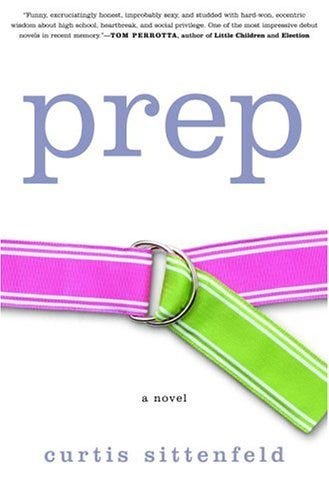When I first saw the cover of Prep by Curtis Sittenfeld, I was transported to my own prep school days as a teenager. My family moved from Minnesota to Augusta, Georgia and because the public schools were terrible, I went to private school and was plunked into an alien world of pink-and-green grosgrain belts, Bass Weejuns, and old-family money.
Sittenfeld’s tale of being an outsider in an insular environment ushered back dozens of memories of all my prep school missteps: lipstick too pink, Midwestern accent, clothes from Sears instead of the tony Fashion Plate.
I can’t remember the last time a novel spoke to me so powerfully, and it obviously spoke to other outsiders looking in because it made the New York Times bestseller list and is now something of a classic.
Random House did an admirable job of clearly communicating what Prep was about with its cover, marketing strategy, and title. (The original title was Cipher, which might not have spoken to as many readers.) I’m grateful that the publisher knew how to speak to potential readers like me because Prep became one of my all-time favorite books.
Similarly, authors must also clearly communicate the message of their novel to agents, editors, and readers through their description and pitches. When an agent is going through the slush, the questions going through her mind are, “Is this for me?” “Which editors might like it?” “What is the audience?”
Often writers describing their novels are too vague or general. I imagine agents reading their submission materials, shaking their heads, saying, “I don’t get this.” If they don’t “get’ what you’re pitching, they’ll reject.
Sometimes, authors who have vague descriptions or pitches also have an unfocused manuscript. But other times, they have a solid book but aren’t skilled at picking out the selling points.
That’s why every area of your query must succinctly communicate your novel’s message. It must say to your target audience, “Yes! This is for you!”
Genre
A recently sold novel by Santana Knox called HEARTLESS HEATHENS is described as a dark dystopian, reverse-harem romance. That’s a lot of information packed into a genre, and it targets a niche audience.
Most of us aren’t going to be able to get that granular, but if you’re writing genre fiction it’s vital to know as much as possible about that genre as possible. For instance, it’s not enough to say you’re writing a thriller. Is it domestic, psychological, or techno?
This gets trickier when you’re writing women’s fiction, literary, or upmarket. None of those classifications reveal much information, but you can sometimes make them more specific. For instance, on Amazon, the women’s fiction novel The Book Club for Troublesome Women by Marie Bostwick is classified as suburban women’s friendship fiction, which is more descriptive.
You can use the BISAC (Book Industry Standards and Communications) classification system to help you drill down on how to describe your book. BISAC is how publishers communicate with retailers about their books. Amazon categories are also helpful. Look at books similar to your own and see what categories they’re placed in.
Titles
Both authors and publishers can be too vague and general when it comes to titles. Good titles convey the book’s tone, content or genre.
Every week I study the new releases and see titles that aren’t communicating as well as they could. This week’s list includes Knave of Diamonds (historical suspense), A Rare Find (queer historical romance), and So Far Gone (literary). These aren’t terrible titles but they communicate little about the book. But bravo to A Botanist’s Guide to Ritual and Revenge (historical mystery), If I Told You I’d Have to Kiss You (rom-com with spies), and A Murder for Miss Hortense (cozy mystery). All give a clear sense of either genre, tone or content.
AI is helpful when brainstorming titles, and I’ve written in the past about how to choose a great title.
Clarity Comps
Clarity comps are comps that are a shorthand way of conveying tone and situation. As long as they’re relevant, there are no rules surrounding them. They can be films, mega bestsellers, or decades old. Clarity comps should be distinguished from comps used by publishers to prepare profit and loss statements. The latter follows strict guidelines (can’t be too old, can’t be a blockbuster etc.). Here’s some examples of clarity comps from published books.
"Percy Jackson for adults!" (Gods of Glenhaven)
Heathers meets The Stepford Wives (Follow Me)
In the spirit of Murder on the Orient Express (Everyone On This Train is a Suspect)
Less is more with clarity comps, Resist the urge to pile a bunch of comps together; it dilutes their effectiveness.
You can drop clarity comps into your one-line pitch and later address the profit-and-loss comps.
Example: Follow Me, pitched as Heathers meets Stepford Wives, a darkly humorous domestic thriller is about a woman who poses as a Mom-fluencer to find clues about her missing sister. Some recent comps include…..
Pitch
I’ve addressed pitches at length in this Substack so I won’t re-hash but there’s a couple of important points I’d like to re-iterate. Many agents are asking for a one-sentence description of your novel, and this is definitely not the place to use generalities like “A woman caught in a web of lies” or “long-times secrets will be revealed in a novel that spans generations.”
Again, remember that your goal is clear communication and generalities don’t help the agent or reader answer the question, “Is this for me?” Specifics are your friend. The only appropriate generalities are those that come after the description, when you might add a sentence about theme.
Always aim for clarity in your pitch. Here’s an example:
DARLING, YOU'RE NEXT, a feminist thriller about a woman who meets the perfect man at a grief support group, only to find out that he might have murdered his ex-wife—and that she might be next.
The above pitch works because there’s little ambiguity about what the above novel is about.
Tagline
Not everyone includes taglines in their query, but a well-chosen one can further communicate your tone and genre. I’ve written about taglines in the past, and once again, AI can help with them:
Here’s some examples from the bestselling list on Amazon:
“I wanted this woman, and I was a man who always got what he wanted.” (Caught Up, a dark romance)
They’d kill to be widows. (The Retirement Plan , dark humor)
The bold, the brave, the wrinkled (The Silver Squad, late-life women’s fiction)
Taglines can serve as the hook for the description.
Description
This is a vital part of a query, and it needs to read like a story, one event springing from the next. I’ve written about how to structure these here.
Here’s an example from Tiny Daggers by Carolyn Corcoran
The most dangerous predators in Miami don’t bite. They brunch. (Tagline which also serves as the hook.)
Expat Holly Jones has built the perfect life for herself in an exclusive area of Miami: the beautiful house, the enviable family. (Status quo) So the last person she expects to bump into one morning is a ghost from her old life in London, someone she hasn’t seen in over twenty years: the other Holly, Holly Wild. (inciting incident)
Single, sexy, and a world away from the frumpy sidekick she was at school, Holly Wild quickly becomes an unavoidable part of Holly Jones’s life. She is everywhere—in her home, in her marriage, and especially in her head. Is this really just a chance reunion or is there something more sinister lurking behind her seemingly flawless facade? (complications)
As the oppressive heat intensifies, Holly Jones is haunted by memories she’s spent decades trying to bury. Is she being paranoid or is Holly Wild really out to steal her life? At school they were known as Good Holly and Bad Holly…but as their twisted game of cat and mouse escalates, it’s no longer clear which one is which… (cliffhanger)
Make sure there’s a cause-and effect throughline in your description so it reads like a story. Again, communication is key. You don’t want readers wondering about the connection of events in your story. To test that your events are connected, use the phrase BECAUSE OF THAT. (Not in the query itself. Just to make sure you have a cause-and-effect throughline.)
Example: Dorothy’s house lands on a witch killing her. BECAUSE OF THAT, the witch’s sister arrives to take her sibling’s ruby slippers, but they shock her and end up on Dorothy’s feet. BECAUSE OF THAT, the witch vows to kill Dorothy.
And yes, all of this is a little daunting and takes a different skill set than writing a novel, but it’s well worth learning. Thoughts? Questions? I love to hear from you.
Need help? For the month of June, I’m running a special on query critique for $50. ($20 off) More info here. Spaces are limited.
NEWS YOU CAN USE
has an insightful post on combating professional jealousy.At a the US Book Show, publishers claim that they want to nurture their midlist authors.
Abbi Jiminez’s entrepreneurial spirit has served her well as an author. (Gift link.)
It’s only June but Esquire and Time are already looking at the best books of 2025.
Book Club picks for June 2025
Popular Substack agent Kate McKean has a new book out for writers who need a little hand-holding. Here’s an interview with her.






I'm just working on the pitch and description of my last novel, and your essay really got me thinking again and reconsidering my whole approach!! Thank you, Karin!
Really helpful yet again! Thank you! This has got me so excited to query soon!